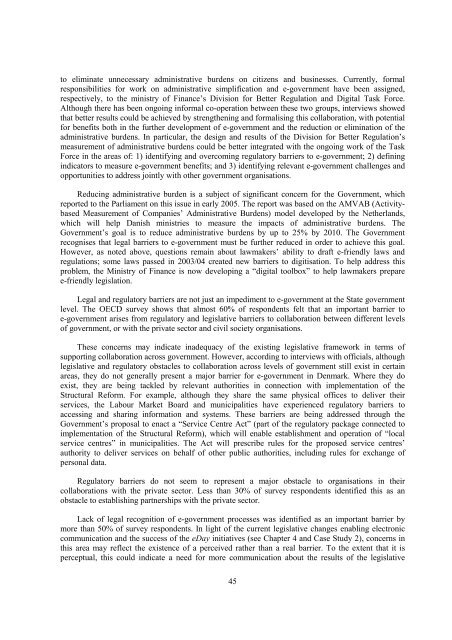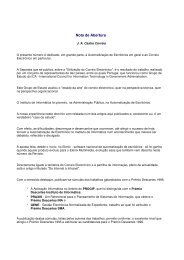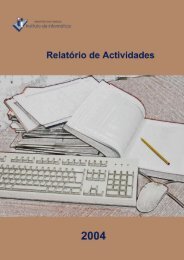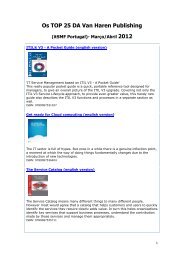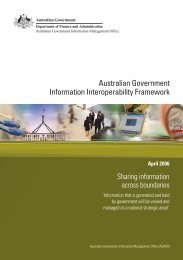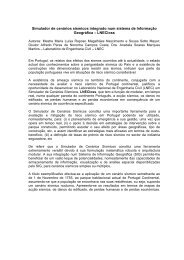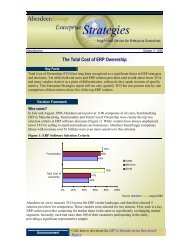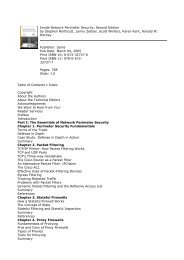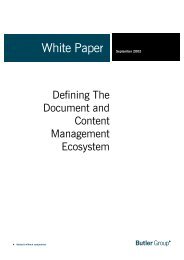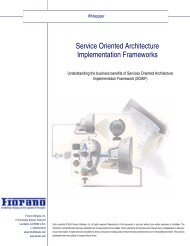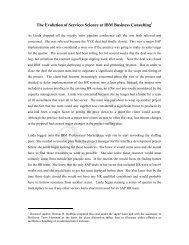OECD Peer Review of E-Government in Denmark - ePractice.eu
OECD Peer Review of E-Government in Denmark - ePractice.eu
OECD Peer Review of E-Government in Denmark - ePractice.eu
Create successful ePaper yourself
Turn your PDF publications into a flip-book with our unique Google optimized e-Paper software.
to elim<strong>in</strong>ate unnecessary adm<strong>in</strong>istrative burdens on citizens and bus<strong>in</strong>esses. Currently, formal<br />
responsibilities for work on adm<strong>in</strong>istrative simplification and e-government have been assigned,<br />
respectively, to the m<strong>in</strong>istry <strong>of</strong> F<strong>in</strong>ance’s Division for Better Regulation and Digital Task Force.<br />
Although there has been ongo<strong>in</strong>g <strong>in</strong>formal co-operation between these two groups, <strong>in</strong>terviews showed<br />
that better results could be achieved by strengthen<strong>in</strong>g and formalis<strong>in</strong>g this collaboration, with potential<br />
for benefits both <strong>in</strong> the further development <strong>of</strong> e-government and the reduction or elim<strong>in</strong>ation <strong>of</strong> the<br />
adm<strong>in</strong>istrative burdens. In particular, the design and results <strong>of</strong> the Division for Better Regulation’s<br />
measurement <strong>of</strong> adm<strong>in</strong>istrative burdens could be better <strong>in</strong>tegrated with the ongo<strong>in</strong>g work <strong>of</strong> the Task<br />
Force <strong>in</strong> the areas <strong>of</strong>: 1) identify<strong>in</strong>g and overcom<strong>in</strong>g regulatory barriers to e-government; 2) def<strong>in</strong><strong>in</strong>g<br />
<strong>in</strong>dicators to measure e-government benefits; and 3) identify<strong>in</strong>g relevant e-government challenges and<br />
opportunities to address jo<strong>in</strong>tly with other government organisations.<br />
Reduc<strong>in</strong>g adm<strong>in</strong>istrative burden is a subject <strong>of</strong> significant concern for the <strong>Government</strong>, which<br />
reported to the Parliament on this issue <strong>in</strong> early 2005. The report was based on the AMVAB (Activitybased<br />
Measurement <strong>of</strong> Companies’ Adm<strong>in</strong>istrative Burdens) model developed by the Netherlands,<br />
which will help Danish m<strong>in</strong>istries to measure the impacts <strong>of</strong> adm<strong>in</strong>istrative burdens. The<br />
<strong>Government</strong>’s goal is to reduce adm<strong>in</strong>istrative burdens by up to 25% by 2010. The <strong>Government</strong><br />
recognises that legal barriers to e-government must be further reduced <strong>in</strong> order to achieve this goal.<br />
However, as noted above, questions rema<strong>in</strong> about lawmakers’ ability to draft e-friendly laws and<br />
regulations; some laws passed <strong>in</strong> 2003/04 created new barriers to digitisation. To help address this<br />
problem, the M<strong>in</strong>istry <strong>of</strong> F<strong>in</strong>ance is now develop<strong>in</strong>g a “digital toolbox” to help lawmakers prepare<br />
e-friendly legislation.<br />
Legal and regulatory barriers are not just an impediment to e-government at the State government<br />
level. The <strong>OECD</strong> survey shows that almost 60% <strong>of</strong> respondents felt that an important barrier to<br />
e-government arises from regulatory and legislative barriers to collaboration between different levels<br />
<strong>of</strong> government, or with the private sector and civil society organisations.<br />
These concerns may <strong>in</strong>dicate <strong>in</strong>adequacy <strong>of</strong> the exist<strong>in</strong>g legislative framework <strong>in</strong> terms <strong>of</strong><br />
support<strong>in</strong>g collaboration across government. However, accord<strong>in</strong>g to <strong>in</strong>terviews with <strong>of</strong>ficials, although<br />
legislative and regulatory obstacles to collaboration across levels <strong>of</strong> government still exist <strong>in</strong> certa<strong>in</strong><br />
areas, they do not generally present a major barrier for e-government <strong>in</strong> <strong>Denmark</strong>. Where they do<br />
exist, they are be<strong>in</strong>g tackled by relevant authorities <strong>in</strong> connection with implementation <strong>of</strong> the<br />
Structural Reform. For example, although they share the same physical <strong>of</strong>fices to deliver their<br />
services, the Labour Market Board and municipalities have experienced regulatory barriers to<br />
access<strong>in</strong>g and shar<strong>in</strong>g <strong>in</strong>formation and systems. These barriers are be<strong>in</strong>g addressed through the<br />
<strong>Government</strong>’s proposal to enact a “Service Centre Act” (part <strong>of</strong> the regulatory package connected to<br />
implementation <strong>of</strong> the Structural Reform), which will enable establishment and operation <strong>of</strong> “local<br />
service centres” <strong>in</strong> municipalities. The Act will prescribe rules for the proposed service centres’<br />
authority to deliver services on behalf <strong>of</strong> other public authorities, <strong>in</strong>clud<strong>in</strong>g rules for exchange <strong>of</strong><br />
personal data.<br />
Regulatory barriers do not seem to represent a major obstacle to organisations <strong>in</strong> their<br />
collaborations with the private sector. Less than 30% <strong>of</strong> survey respondents identified this as an<br />
obstacle to establish<strong>in</strong>g partnerships with the private sector.<br />
Lack <strong>of</strong> legal recognition <strong>of</strong> e-government processes was identified as an important barrier by<br />
more than 50% <strong>of</strong> survey respondents. In light <strong>of</strong> the current legislative changes enabl<strong>in</strong>g electronic<br />
communication and the success <strong>of</strong> the eDay <strong>in</strong>itiatives (see Chapter 4 and Case Study 2), concerns <strong>in</strong><br />
this area may reflect the existence <strong>of</strong> a perceived rather than a real barrier. To the extent that it is<br />
perceptual, this could <strong>in</strong>dicate a need for more communication about the results <strong>of</strong> the legislative<br />
45


